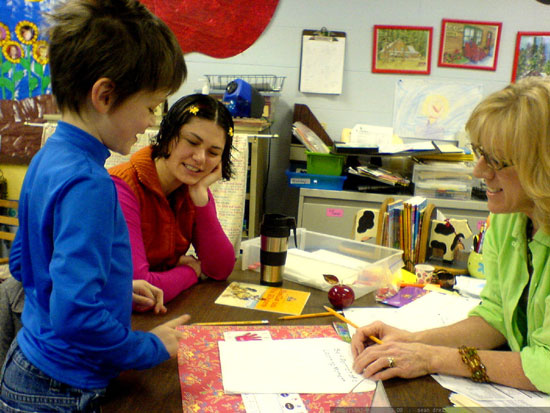Teachers admit that building strong relationships with parents of students can be challenging. And most parents and guardians would agree. Building positive parent-teacher relationships is truly a lifelong skill. Countless books and articles have been written on the subject, including this recent New York Times article about how to avoid the pitfalls that cause everybody, students especially, unnecessary anxiety.
As a teacher, I have witnessed a lot of anxiety. Working with anybody—whether other teachers, administrators, parents or community members—can be stressful, but parent-teacher relationships don’t have to be conflict-ridden. These adults can be true allies.

A positive teacher-parent relationship is based on the mutual goal of
educating and supporting the child.
Photo credit: Sean Dreilinger
Teaching Tolerance offers a general resource about family engagement that can be tailored to any teacher’s needs. Whether you teach in an elementary classroom where 20-some-odd children spend most of the day or in a large high school with 150 students in each teacher’s roll book, the strategies in this resource can be customized to your unique school culture.
My fellow kindergarten teachers and I have a long history of reaching out to and actively involving parents. We communicate with parents on a near-daily basis as they drop-off and pick-up students in our classroom. Understandably, things may be different than in most classrooms. That said, a little goes a long way. Below are some of the things I have seen that really contribute to strong parent-teacher relationships.
Last fall, another TT blogger suggested thanking parents as a simple and direct way to reach out. I love this. Small acts, even sharing something a child has done in the classroom, are easy with digital cameras and smartphones. A few clicks and an email is on its way to the parent or guardian. Teachers could also print out photos of a student at work—reading, writing, building, creating, singing—and send them home. The student could benefit also; she is being entrusted to bridge the school-to-home connection. A simple phone call to a parent reporting what the child is accomplishing goes a long way as well, especially when a phone call from a teacher might traditionally be to report something negative.
Our school administrators encourage family visits at the start of every school year as a way to put the home-school relationship on solid ground. The visit can occur in a library, park or coffee shop. A phone conversation over the summer is also a nice connection. It offers the chance for the responsible adult at home, teachers and children to establish common ground and friendly relations before the beginning of the school year.
Relationships are central to student learning. The American Psychological Association tells us that students with close, positive relationships with teachers outperform their peers without these relationships.
Parents and guardians have a lot to offer: stories, skills, ideas and identities. In my classroom, they come in and read stories that are relevant to their cultural or professional identities, especially when there is overlap with the curriculum. Parents can share their personal histories with the class or offer materials and supplies—from scrap paper to collage materials to tools. Of course, some parents may be too busy, overworked, or overstressed, to visit a classroom during the workday.
Things are even more complicated at the high school level, where the curriculum is more demanding. The Harvard Family Research Project determined that the most effective (and common) mode of involvement relates to parents’ expectations of students and has a direct effect on student achievement. Schools administrators and teachers can use this to their advantage by offering workshops or allowing families to reserve time to discussing curricular and extracurricular topics. Teachers can introduce themselves to parents in writing or by phone and keep the lines of communication open.
Keep in mind that connecting to parents and guardians, via phone or a personal note, sends students a powerful message of mutual care and responsibility. What greater lesson could there be?
Palenski is a kindergarten teacher in Connecticut.

0 COMMENTS